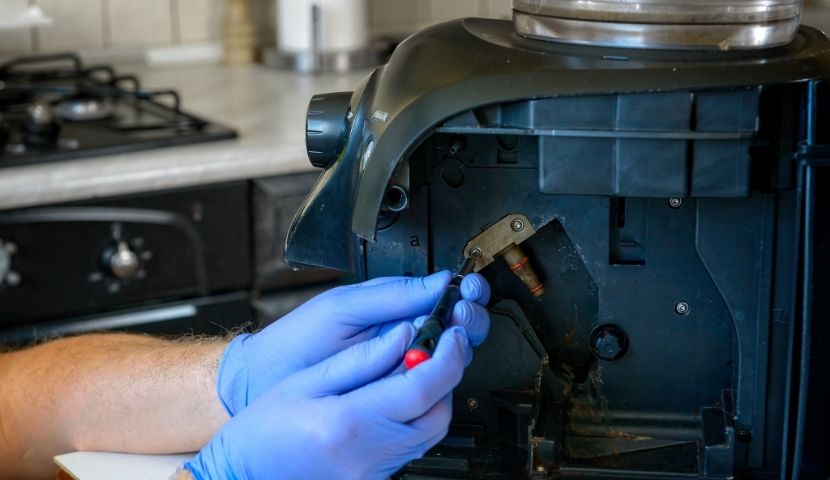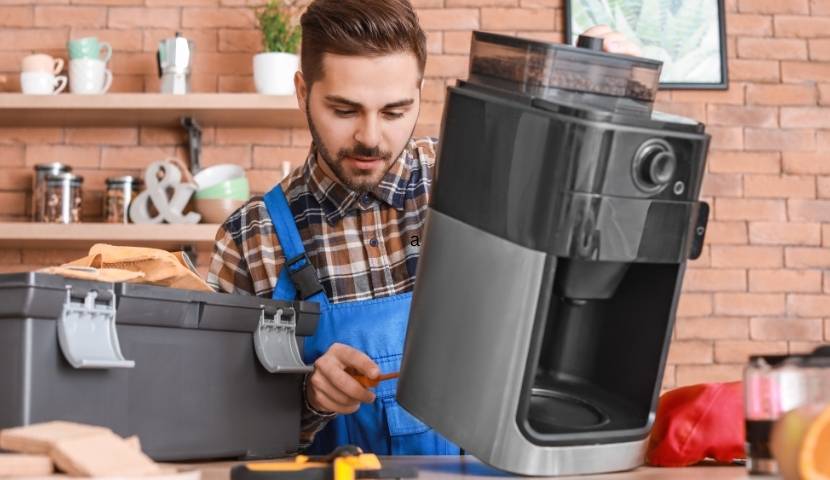There’s nothing quite like the aroma of freshly brewed coffee to kickstart your day. A reliable coffee maker is essential for delivering that perfect cup each morning, making it an indispensable part of many households. However, when these machines malfunction, it can disrupt our daily routine and leave us longing for our caffeine fix.
In this guide, we’ll explore common issues that plague coffee makers and provide straightforward solutions to get them back in action. Whether it’s a stubborn filter, heating hiccups, or mysterious leaks, we’ve got you covered.

By understanding these common problems and their fixes, you can extend the life of your coffee maker and ensure your mornings remain uninterrupted.
Why Coffee Makers Stop Working
Understanding why your coffee maker isn’t functioning properly can save you time, money, and frustration.
Here are some common culprits:
Regular Wear and Tear
Over time, the constant heating and cooling cycles can cause components like the heating element or thermostat to wear out. This natural degradation can lead to malfunctioning parts that affect the brewing process.
Tip: Regularly inspect your coffee maker for signs of wear. If certain parts appear damaged or worn, consider replacing them to maintain optimal performance.
Build-up of Mineral Deposits (Scale)
If you live in an area with hard water, mineral deposits can accumulate inside your coffee maker. This scaling can clog water lines and heating elements, leading to inefficient brewing and potential overheating.
Solution: Descale your coffee maker monthly using a mixture of equal parts white vinegar and water. Run this solution through a brewing cycle, followed by two cycles of clean water to rinse. This helps remove mineral buildup and keeps your machine running smoothly.
Power Issues
Electrical problems are a common cause of coffee maker malfunction. Issues such as faulty power cords, malfunctioning switches, or internal fuse failures can prevent your machine from turning on or heating properly.
Checklist:
- Ensure the power cord is securely plugged in and free from visible damage.
- Test the outlet with another device to confirm it’s supplying power.
- Inspect the on/off switch for any signs of malfunction.
- Consult your coffee maker’s manual to locate and test internal fuses if necessary.
Clogging or Mechanical Failure
Coffee makers have intricate internal mechanisms that can become clogged with coffee grounds or suffer mechanical failures over time. Clogs can restrict water flow, leading to weak or incomplete brews.
Prevention: Use the appropriate grind size for your coffee maker and avoid overfilling the filter basket. Regularly clean the filter and brewing components to prevent clogs.
Faulty Parts
Components such as the heating element, thermostat, or water pump can fail due to manufacturing defects or prolonged use. Identifying faulty parts requires careful inspection and, in some cases, professional assistance.
Recommendation: If you suspect a part is malfunctioning, consult your coffee maker’s warranty and consider reaching out to the manufacturer’s customer service for guidance.
Remember, regular maintenance and attentive care are key to prolonging the life of your appliance and ensuring your daily coffee ritual remains uninterrupted.
Common Coffee Maker Problems and How to Fix Them
Encountering issues with your coffee maker can be frustrating, but many problems are straightforward to resolve.

Here’s a guide to some frequent issues and their solutions:
Problem 1: Coffee Maker Won’t Turn On
Possible Causes:
- Power Cord Issues: A damaged or disconnected power cord can prevent your coffee maker from turning on.
- Internal Fuse or Electrical Problems: Blown fuses or internal electrical faults can disrupt the machine’s operation.
Solution:
- Check the Power Source: Ensure the coffee maker is securely plugged into a functional outlet. Test the outlet with another device to confirm it’s working.
- Inspect the Power Cord: Examine the cord for visible damage. If damaged, the cord may need to be replaced.
- Reset the Machine: Some models have a reset function. Refer to your user manual to perform a reset.
- Test Internal Components: If comfortable, unplug the machine and access internal components to check fuses and connections. Otherwise, seek professional assistance.
Problem 2: Water Isn’t Heating
Possible Causes:
- Broken Heating Element: A malfunctioning heating element can prevent water from reaching the desired temperature.
- Clogged Water Lines: Mineral deposits can block water flow, affecting heating efficiency.
- Electrical Failures: Issues with thermostats or wiring can disrupt heating functions.
Solution:
- Inspect the Heating Element: Use a multimeter to test the heating element for continuity. A lack of continuity indicates a faulty element.
- Descale the Machine: Run a descaling solution (e.g., white vinegar diluted with water) through the brewing cycle to clear mineral build-up.
- Check Electrical Components: Ensure thermostats and wiring are intact. If issues persist, consult a professional technician.
Problem 3: Coffee Maker Leaking Water
Possible Causes:
- Damaged Seals: Worn-out seals can lead to leaks.
- Cracked Reservoir: Physical damage to the water reservoir can cause leaking.
- Overflowing Filter: Overfilled or improperly placed filters can result in spills.
Solution:
- Inspect Seals and Gaskets: Check for signs of wear or damage. Replace any compromised seals.
- Examine the Reservoir: Look for cracks or leaks. If damaged, contact the manufacturer for a replacement.
- Adjust Filter Usage: Ensure filters are correctly positioned and not overfilled.
Problem 4: Coffee Tastes Bad or Weak
Possible Causes:
- Clogged Coffee Filter: Residue can affect the taste and strength of your coffee.
- Stale Coffee Grounds: Using old or improperly stored coffee can lead to flavor loss.
- Incorrect Water Temperature: Water that’s too cool or hot can impact extraction.
Solution:
- Clean the Coffee Filter: Regularly clean or replace filters to prevent build-up.
- Use Fresh Coffee Grounds: Grind beans just before brewing and store them properly to maintain freshness.
- Check Water Temperature: Ensure your machine heats water to the optimal brewing temperature (195°F to 205°F).
Problem 5: Coffee Maker is Slow or Doesn’t Brew Completely
Possible Causes:
- Clogged Brew Basket: Obstructions can hinder water flow.
- Mineral Build-Up: Scale can restrict water movement.
- Filter Issues: Improper filters can affect brewing efficiency.
Solution:
- Clean the Brew Basket: Regularly remove coffee grounds and clean the basket.
- Descale the Machine: Perform regular descaling to prevent mineral accumulation.
- Check Filters: Use the recommended filter type and ensure it’s properly seated.
Preventative Maintenance for Coffee Makers
Regular maintenance not only extends the life of your coffee maker but also ensures each cup is as delightful as the last. Here’s how to keep your machine in prime condition:
Importance of Regular Cleaning
Regular cleaning prevents the buildup of coffee oils and mineral deposits, which can affect both the taste of your coffee and the longevity of your machine. A clean coffee maker ensures optimal performance and a fresh brew every time.
Descaling Guide
Descaling removes mineral deposits that accumulate over time, especially in areas with hard water. These deposits, known as scale, can clog internal components and reduce your coffee maker’s efficiency. Descaling your coffee maker regularly helps maintain proper water flow, ensuring consistent brewing performance and preventing long-term damage.
How to Descale Your Coffee Maker:
- Prepare the Descaling Solution: Mix equal parts white vinegar and water. Alternatively, you can buy commercial descaling solutions designed specifically for coffee makers.
- Run the Solution Through the Machine: Pour the vinegar-water mixture into the water reservoir and start a brewing cycle, but don’t add coffee grounds. This will help break down the mineral build-up.
- Rinse the Machine: After the cycle is complete, run two cycles of clean water through the machine to flush out any remaining vinegar solution and mineral residue.
- Repeat as Needed: Depending on your water hardness and usage, descaling every 1-3 months is recommended.
Filter Replacement and Water Quality
The type of filter you use and the quality of water in your coffee maker can have a significant impact on both taste and machine longevity. Over time, filters can become clogged, which affects water flow and the overall brewing process.
- Replace the Filter Regularly: For drip coffee makers, replace paper filters after each brew, and clean or replace permanent filters periodically to ensure optimal performance.
- Use Clean, Filtered Water: Hard water can cause mineral build-up, while tap water with impurities can affect the taste of your coffee. Using filtered or bottled water helps maintain both the flavor and longevity of your coffee maker.
Long-Term Care
Maintaining your coffee maker is an ongoing effort. In addition to regular cleaning and descaling, it’s important to take good care of the machine’s components and follow the manufacturer’s guidelines.
- Proper Storage: If you’re not using your coffee maker daily, store it in a dry, cool place to avoid dust buildup or mold growth in the water reservoir.
- Periodic Checks: Every few months, inspect your coffee maker for signs of wear and tear, like cracks in the reservoir or frayed power cords. Replacing these parts as needed will prevent further issues down the line.
- Professional Servicing: If your coffee maker shows signs of persistent issues that you can’t resolve, consider taking it to a professional for servicing. It’s a great way to avoid unnecessary damage and keep your machine in working order for years to come.
Troubleshooting Tips for Different Types of Coffee Makers
Understanding the unique features and common issues of your specific coffee maker can greatly enhance your brewing experience. Here’s a breakdown of typical problems and solutions for various coffee maker types:

Drip Coffee Makers
Common Issues:
- Clogged Filters: Over time, coffee grounds can clog the filter, leading to slow brewing or incomplete extraction.
- Slow Brewing: This can result from mineral buildup or a partially blocked water line.
Solutions:
- Clean the Filter: Regularly remove and rinse the filter to prevent clogging.
- Descale the Machine: Use a mixture of equal parts white vinegar and water to descale. Run this solution through a brewing cycle, followed by two cycles of clean water to rinse.
Single-Serve Coffee Makers (e.g., Keurig)
Common Issues:
- Water Not Dispensing: Clogs in the needle or water line can prevent water flow.
- Coffee Pods Not Brewing: This may be due to a misaligned pod, clogged needle, or machine malfunction.
Solutions:
- Clean the Needle: Use a paperclip to gently clear any debris from the needle that punctures the pods.
- Descale Regularly: Perform descaling every 3-6 months using a vinegar solution to prevent mineral buildup.
- Check Pod Placement: Ensure pods are correctly placed and not expired.
Espresso Machines
Common Issues:
- Pressure Problems: Inconsistent or low pressure can affect espresso quality.
- Steam Wand Issues: Blocked or malfunctioning steam wands can hinder milk frothing.
Solutions:
- Maintain Proper Pressure: Regularly check and adjust the pressure gauge according to the manufacturer’s guidelines.
- Clean the Steam Wand: After each use, purge and wipe the steam wand to prevent milk residue buildup.
- Regular Maintenance: Schedule periodic professional servicing to ensure all components function optimally.
When to Call a Professional Technician
While many coffee maker issues can be resolved with basic troubleshooting, certain situations warrant professional intervention to ensure safety and proper functionality.

Signs Your Coffee Maker Needs Professional Repair:
- Persistent Electrical Issues: Frequent tripping of circuit breakers or malfunctioning electrical components may indicate underlying problems that require expert attention.
- Complex Mechanical Failures: Issues like persistent leaks, malfunctioning pressure systems, or internal component failures often necessitate professional diagnosis and repair.
- Expired Warranty: Attempting DIY repairs on machines under warranty can void coverage. It’s advisable to consult the manufacturer or an authorized technician to maintain warranty validity.
How to Find a Good Technician:
- Research and Reviews: Look for certified technicians with positive customer feedback. Online reviews and recommendations can provide valuable insights.
- Manufacturer Recommendations: Consult your coffee maker’s manufacturer for authorized service providers familiar with your specific model.
- Professional Associations: Technicians affiliated with professional organizations, such as the Coffee Technicians Guild, often adhere to industry standards and ongoing training.
Expert Tips for Choosing a Durable Coffee Maker
Investing in a high-quality coffee maker can enhance your daily coffee ritual and save you money in the long run. Here’s what to consider:
Key Features to Look For:
- Durability: Opt for machines made with high-quality materials like stainless steel, which can withstand daily use and resist wear and tear.
- Ease of Cleaning: Choose models with removable, washable components and designs that facilitate straightforward cleaning to maintain optimal performance.
- Brewing Speed: Consider your morning routine; if time is of the essence, select a coffee maker that brews quickly without compromising flavor.
- Brand Reputation: Research brands known for reliability and excellent customer service to ensure your investment is protected.
Popular Coffee Maker Brands:
- Technivorm: Renowned for the Moccamaster series, these machines are celebrated for their durability and exceptional coffee quality.
- Breville: Offers a range of machines, from entry-level to high-end, known for innovative features and sturdy construction.
- Ninja: Recognized for versatility, Ninja brewers accommodate various coffee styles and are built to last.
- Bonavita: Praised for simplicity and reliability, Bonavita machines deliver consistent performance over time.
- Keurig: Ideal for single-serve convenience, Keurig offers a variety of models with user-friendly designs.
FAQs
How often should I clean my coffee maker?
Regular cleaning is essential to maintain the taste of your coffee and the longevity of your machine. For drip coffee makers used daily, it’s recommended to clean them monthly. Single-serve machines like Keurig should have their exterior cleaned frequently, with deep cleaning and descaling of internal components monthly.
What is descaling, and how do I do it?
Descaling removes mineral deposits (scale) that accumulate over time, especially in areas with hard water. To descale, mix equal parts white vinegar and water, fill the water reservoir, and run a brewing cycle without coffee grounds. Repeat this process until the reservoir is empty, then run several cycles with clean water to rinse.
My coffee tastes bitter after reheating. Why is this?
Reheating coffee, especially in the microwave, can enhance its bitterness due to chemical changes triggered by sudden heat. To avoid this, it’s best to drink coffee within an hour of brewing or use a self-heating mug to maintain warmth.
How can I prevent my coffee from cooling too quickly?
To keep your coffee warm without compromising flavor, consider preheating your mug with hot water before brewing. Using an insulated mug with a lid can also help maintain warmth for longer periods.
Are there specific maintenance tips for single-serve coffee makers like Keurig?
Yes, for single-serve machines, it’s important to clean the exterior frequently and perform deep cleaning and descaling of internal components monthly. This helps prevent clogs and ensures optimal performance.
What should I do if my coffee maker isn’t brewing hot enough?
If your coffee isn’t brewing at the desired temperature, first ensure that the machine is properly cleaned and descaled, as mineral buildup can affect heating efficiency. If the issue persists, consult the manufacturer’s guidelines or contact a professional technician.
How can I maintain the flavor of my coffee over time?
To preserve coffee flavor, store beans in a cool, dark place in an airtight container. Grind beans just before brewing and use filtered water to avoid introducing impurities that can affect taste.
Why is my coffee maker leaking water?
Leaks can result from damaged seals, improperly seated water reservoirs, or clogged internal components. Inspect seals and gaskets for wear, ensure the water reservoir is properly seated, and regularly clean the machine to prevent leaks.
How can I fix a coffee maker that won’t turn on?
First, check that the machine is properly plugged in and that the outlet is functioning. Inspect the power cord for damage and ensure any internal fuses are intact. If the machine still doesn’t turn on, consult the manufacturer’s troubleshooting guide or contact a professional technician.
What are the benefits of using filtered water in my coffee maker?
Using filtered water reduces mineral buildup and removes impurities that can affect both the taste of your coffee and the longevity of your machine.
Regular maintenance and attentive care can significantly enhance your coffee experience and extend the lifespan of your coffee maker.
Conclusion
In summary, understanding common coffee maker issues and implementing proactive maintenance can significantly extend your machine’s lifespan. Regular cleaning, descaling, and mindful usage are key practices.
| Maintenance Task | Why It’s Important | How Often | Tip |
|---|---|---|---|
| Regular Cleaning | Prevents build-up of oils and mineral deposits | Weekly | Clean removable parts after every use |
| Descaling | Removes mineral deposits that clog internal parts | Every 1-3 months | Use equal parts white vinegar and water |
| Filter Replacement | Ensures proper water flow and better coffee taste | Every brew (paper filter) or every 1-2 months (permanent filter) | Replace paper filters after each use |
| Water Quality Check | Improves coffee taste and prevents scale build-up | Ongoing | Use filtered or bottled water |
| Long-Term Care (Storage & Checks) | Extends machine lifespan and prevents mold buildup | Every few months | Inspect for wear and tear; store in a dry place |
We’d love to hear about your experiences with coffee maker repairs or any questions you might have. Please share them in the comments section below!



0 Comments